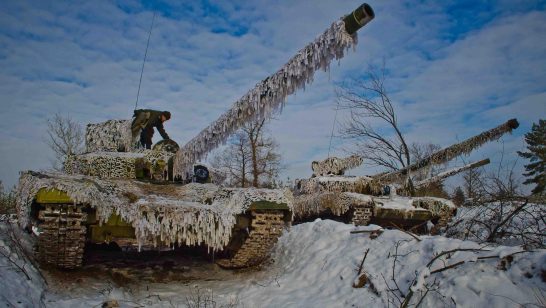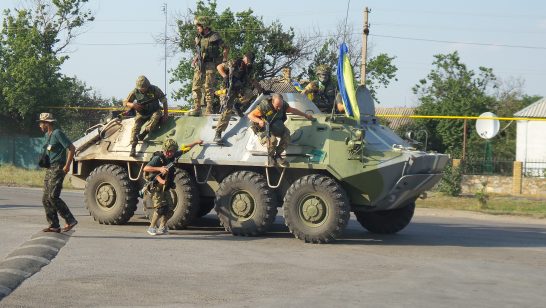
Overshadowed by Russia’s intervention in Syria and the EU’s preoccupation with the migration crisis, the implementation of the second Minsk agreement has received little attention in the past few months. Following the meetings of the Normandy Four Group on 13th February and 3rd March, it seems little progress was made on the most contentious issues with all sides becoming more steadily disillusioned with the process. The principal political elements of the agreement remain unfulfilled and the lack of more satisfactory results produced by both sides is placing further strain on the already protracted negotiations. Against the backdrop of this political stalemate, the OSCE’s Special Monitoring Mission (SMM) has been reporting an increase of ceasefire violations and frequently observed heavy weapons and armed formations.[1]
Considering the track record so far and the insufficient impetus for change, it is unlikely that the local elections in the separatist regions will take place in the latest proposed timeframe. Instead, parties to the agreement must focus on strengthening security in the region and agree on interim mutually-acceptable measures that would serve as building blocks for a permanent solution to the crisis.
Granted, some practical measures have been proposed for strengthening the ceasefire regime. Withdeadlines of 30th April 2016, the first measure was the creation of a ‘mechanism to prevent and resolve incidents’; and the second, the release/exchange of all prisoners and illegally detained persons. Information on the specifics of the incident prevention mechanism is yet to be publically shared. As for the prisoners exchange, on 20 April 2016 the parliamentary envoy for human rights in the Rada confirmed that a fifth ‘transfer’ has taken place bringing the number of exchanged Ukrainian prisoners to 87, but the process is not yet complete. Lastly, with a deadline for the end of March, Ukrainian authorities and leaders in the separatist regions were set to complete a demining map for the Donbass. At the last meeting of the OSCE’s Forum for Security Co-operation (FSC), which took place in mid-April, it was reported that the SMM observed no systematic, organised action on that point.
With regard to the political process, and the holding of local elections in the Donetsk People’s Republic (DPR) and Luhansk People’s Republic (LPR) more specifically, the ‘key’ outcome was the common ‘wish’ that the elections be held by the middle of 2016. Given that the suggested timing of these elections was previously set for this spring (after being postponed from last autumn), this does not indicate any real progress. The mid-summer election date was also questioned by the Chairman of Ukraine’s Central Election Commission, Oleksiy Koshelia, who shared his doubts that elections can be held even in two years’ time. After her visit to Ukraine at the end of April, Victoria Nuland, US Assistant Secretary of State for European and Eurasian Affairs, rejected speculations about US insistence on a June/July date for the elections in the Donbass casting further doubts on the timing. Moreover, the request for the OSCE to provide ‘concrete, practical options for adequately making the elections safe’ by 31st March 2016 seems to have not been fulfilled. In fact, at the end of April a spokesperson from the German Foreign Office mentioned that the OSCE Secretariat’s report is still not ready and that ‘it is too early to say what the findings will be‘.
Decisive progress on the implementation of the Minsk II agreement seems contingent on three factors.
Firstly, the uncertainty over the current power arrangements in Ukraine is presenting a challenge. At the moment the parties in government, the Poroshenko Block and People’s Front, hold 141 and 81 seats in the Rada. They can only master majority if supported by independent MPs, which was the case in the new Prime Minister’s appointment. The government may not be able to evoke greater legislative reforms needed for organising the local elections in the Donbass. Further, while the two parties are trying to move beyond the recent corruption scandals, politicians would be even more reluctant to pass the unpopular reforms granting the DPR and the LPR autonomy. The appointment of Volodymyr Groysman as Prime Minister does bring some stability to the political landscape; however, the Minsk process would be further down the priority list.
Secondly, it is in Russia’s interest to delay the peace process and ‘freeze’ the conflict in the Donbass as it is. By prolonging the process of implementing the flawed Minsk II agreement, Russia is benefiting from the scandals in Ukraine’s domestic politics and the inability of the current administration in Kyiv to consolidate power to counter Russian influence. Further, a frozen military conflict on the territory of the Donetsk and Luhansk regions would prevent Ukraine from achieving closer integration with the EU. This would present Russia with an advantage in future relations with its neighbour.
The EU’s increasingly difficult task of presenting unified positions vis-à-vis Ukraine or Russia is the third factor casting doubts over the future of the Minsk process. Representatives in the Normandy Four Group, Germany and France’s Foreign Ministers have indicated that they are more and more willing to compromise on the ‘modalities’ of holding elections in the Donbass, meaning that elections might be held without being able to meet the OSCE/Office for Democratic Institutions and Human Rights (ODIHR) standards.[2] Not only would this alienate the majority of the Ukrainian population, but it could discredit the EU’s commitment to democratic values. Further, a compromise on the modalities would likely disappoint EU member states that take a stronger view on the relationship with Russia. Such dissonance is even more disturbing in light of the last meeting of the EU’s Foreign Ministers, after which it was reported that there is a growing opposition to the automatic renewal of sanctions against Russia. Despite doubts over the efficacy of the sanctions, they solidified European unity and efforts to prevent Russia from further destabilisation of the situation in Ukraine.
A practical step towards speeding up the political process would be to enhance security in the Donbass by supporting the work of the SMM. A key challenge to the mission at present is limited access to the Donbass region. Despite the fact that Russia is not party to the Minsk II agreement, as a guarantor of its implementation and a de facto supporter of the separatists, the Moscow administration can do more to facilitate the process. If Putin’s administration stands by its commitment to the successful conclusion of the crisis, it could also support the deployment of an international police mission.[3] Such a mission could increase security during local elections. However, the Russian representative and his counterparts from the separatist regions excluded this option.
With respect to the role of the partners in Europe, the EU should focus on establishing a common position regarding Ukraine and consider the broader message it is sending to the Ukrainian people. Encouraging a strong civil society and democratic values cannot be done by compromising on fundamental democratic principles such as the holding of free, fair and secure elections. Hence, partners in the West should not agree to the holding of elections which do not fulfil the ODIHR’s criteria, nor should they insist that the political elements of the Minsk Protocol be fulfilled until security can be ensured.
For their part, Kyiv’s administration should accept that a political solution would involve Russia. The much speculated Medvedchuk plan is one example of striking a balance that could be acceptable to all. [3] Establishing interim administrations in the DPR and LPR headed by people that the separatists, Moscow and Kyiv can support, as suggested by Medvedchuk, could be a practical solution. They would oversee a mutually-agreed transition period leading up to local elections. Even though the plan was flawed due to speculations on the reputations of the proposed candidates, it remains one of the few constructive suggestions for overcoming the current impasse. Finding prospective leaders in the Donbass who can gain support from the administrations in both Kyiv and Moscow would be difficult, but not impossible. And it will be an important step to agreeing on and holding local elections.
[1] The daily updates on the activities of the Special Monitoring Mission are available here:http://www.osce.org/ukraine-smm/reports. Concerns over the intensified violence were also raised by the EU and US delegations at the plenary session of the OSCE Forum for Security Co-operation on 9 March 2016: http://www.osce.org/fsc/227661. Also reported by international media: see the New York Times article from 22 February. A ‘full’ ceasefire was negotiated on the eve of the Orthodox Easter (more details can be found here:https://www.bundesregierung.de/Content/EN/Artikel/2016/04_en/2016-04-29-ukraine-waffenruhe_en.html); however, casualties were reported shortly after that ceasefire took effect:http://www.aljazeera.com/news/2016/04/ukraine-crisis-troops-killed-east-truce-160430123729171.html.
[2] See comments by Steinmeier in March 2016 ‘elections cannot be delayed indefinitely’ –http://www.kyivpost.com/article/content/ukraine-politics/local-elections-in-eastern-ukraine-cannot-be-delayed-endlessly-steinmeier-410515.html, and the comment on the ELN website from January 2016:http://www.europeanleadershipnetwork.org/should-ukraine-agree-to-imperfect-local-elections-in-the-donbass_3442.html.
[3] The possibility of an armed OSCE mission to eastern Ukraine was questioned by a spokesperson from the German Foreign Office given that no precedent exists: http://www.auswaertiges-amt.de/EN/Infoservice/Presse/Meldungen/2016/160427_Ostukraine.html.
[4] The idea was raised at the end of February and discussed until mid-March when a Ukrainian representative denounced it: http://en.interfax.com.ua/news/general/330756.html. A short analysis can be found here: http://blogs.ft.com/beyond-brics/2016/03/16/a-last-chance-to-unify-ukraine/.
The opinions articulated above represent the views of the author(s), and do not necessarily reflect the position of the European Leadership Network or any of its members. The ELN’s aim is to encourage debates that will help develop Europe’s capacity to address the pressing foreign, defence, and security policy challenges of our time.



